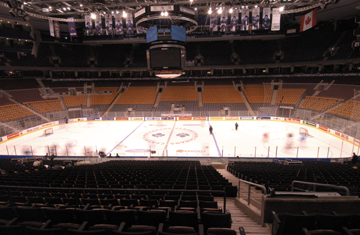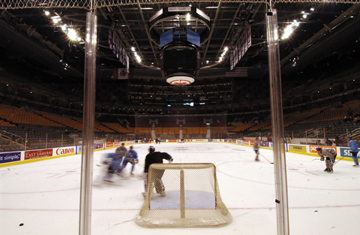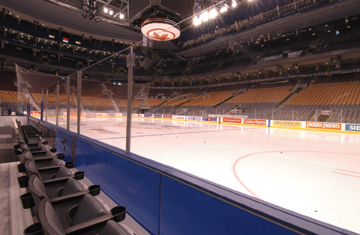|
Acrylic Spectator Shielding Is Making A Comeback With Indoor Arenas
The crash of the boards, the slap of the puck; sights
and sounds that drive hockey fans wild and the only
thing standing between them and a 90 mph hockey
puck is spectator shielding. Indoor arena sports have a
tendency to move fast and hard in a smaller game play
area than outside stadiums. Sports like soccer, arena football,
lacrosse and hockey are quick and exciting games.
 Much of the speed and excitement ends up crashing into
the spectator shielding above dasher panels.
Much of the speed and excitement ends up crashing into
the spectator shielding above dasher panels.
Arena spectator shielding has been a topic of much discussion
over the last few years, involving coach and player
complaints, clarity issues and impact resistance. A solution
to these issues is taking hold with indoor arenas as
they begin to make the switch from seamless glass to
acrylic shielding systems. The reasons are to reduce player
injury and complaints and ease facility changeovers.
Crashing the Boards
An argument being presented in many debates over
spectator shielding systems is the rigidity of tempered
glass versus that of acrylic shielding. Concerns looming
throughout the hockey industry have many facilities looking
at acrylic and many team officials requesting it. Acrylic
is approximately 64 percent lighter than an equally sized
glass panel. Acrylic is also 20-25 times more flexible than
tempered glass. The flexibility of an acrylic shielding system
is a major factor to consider when a player is impacting
shields at accelerated speeds. Both the shielding and
the player will absorb the force of the impact. Due to player
and coaching staff complaints, some arenas have
already made the switch to acrylic shielding.
The NHL requires the use of a 200 pound load to test
the impact on its shielding systems. Computer models
show that a 200 pound player skating at 15 mph will generate 63,553 psi of stress on tempered glass. The reaction
force distributed back to the player is 54,820 pounds
Under the same conditions, if the 200 pound player were
to impact acrylic shielding, he would generate 15,555 psi
of stress on the acrylic and only 20,720 pounds of reaction
force would be redistributed back to the player. This
three-fold reduction in reaction forces significantly reduces
the effects of the impact and the possibility of injury.
These numbers show why players are more likely to suffer
head, neck or upper body injuries when impacting tempered
glass instead of acrylic.
Some venues have found that replacing the large 4’ x 8’
glass panels located behind the goal, where most player-to-
board contact occurs, makes a significant improvement
in player comfort and event changeovers.
Feeling the Impact
When seamless glass systems
were first installed in
arenas, it was facility staff
that first felt the “impact.”
Seamless glass panels, although
the same size as
acrylic panels, weigh approximately
100 pounds more.
 The additional weight on the
larger panels behind goals
called for expensive slow
moving lifts to perform arena
changeovers. Additional facility
labor costs are required
to break down and set-up
facility configurations from
event to event.
The additional weight on the
larger panels behind goals
called for expensive slow
moving lifts to perform arena
changeovers. Additional facility
labor costs are required
to break down and set-up
facility configurations from
event to event.
The popularity and game
frequency of indoor sports is
at an all-time high, as
lacrosse, soccer and arena football have captured the attention
of the American public. With both soccer and lacrosse
utilizing spectator shielding along with hockey, facilities are
required to perform more changeovers per week, staffing
for as many as 3 events a day. With the added frequency of
these events, facility management began to notice the
added changeover burden
glass panels carried. In order
to cope, some facilities, such
as the First Union Center in
Philadelphia, have implemented
a hybrid shielding system
where both acrylic and glass
are used, whereby the larger
panels behind the goal are
made of acrylic. This has
helped speed changeover
time and has eliminated the
need for specialty lifts, as two
or more arena personnel can
easily handle the large acrylic
panels.
“We’re seeing more and
more arenas making the
switch to acrylic shielding
especially in light of the
recent developments in spe-cialty
coated acrylic products,” commented John Korney,
Commercial Development Manager Sheet Products,
CYRO Industries. CYRO, based in Rockaway, NJ, has an
acrylic product guaranteed to meet ASTM F 1703-96 for
spectator shielding, ACRYLITE® RinkShield™ acrylic sheet.
Breaking Through
While shielding stiffness and player complaints remain a
major issue, shielding impact strength has not been an
issue because both glass and acrylic have proven to be
effective, incurring a comparable amount of breakage. The
fact to consider is that when glass panels break they shatter
into tiny fragments as opposed to acrylic, which breaks
into large pieces. It is not a common occurrence but if a
panel breaks, acrylic facilitates faster clean up and
replacement over glass panels. Two facility personnel could
change panels in a timely fashion without the need of special
lift equipment.
Seeing the Difference
Clarity is an important issue, predominantly with so
many sporting events being televised and broadcast globally.
Glass has long been thought to offer ideal optical conditions
but in actuality acrylic offers better light transmission
for improved optical clarity. Acrylic panels can also be
specialty coated to resist scratches and puck marks to
improve game viewing.
 “Manufactured to ASTM specs for hockey arenas,
RinkShield acrylic sheet holds up to puck and player
impacts, provides softer impacts versus tempered glass,
clear viewing for fans and easier, quicker changeover
operations for facilities,” commented Korney.
“Manufactured to ASTM specs for hockey arenas,
RinkShield acrylic sheet holds up to puck and player
impacts, provides softer impacts versus tempered glass,
clear viewing for fans and easier, quicker changeover
operations for facilities,” commented Korney.
While acrylic supported dasher systems absorb impact
well, it has also been said that they provide louder and
more exciting impact sounds for fans and spectators. As
players wrestle for puck control against the boards, fans
are able to hear the on-ice excitement better with acrylic
dasher systems due to the shock absorbing movement of
the system. Because of the impact absorption, movement
impact volume is amplified and grabs fan attention,
enhancing the level of excitement of the game.
With NHL and player concerns regarding shielding
and dasher systems, changeover benefits and lighter
weight, acrylic shielding is making a comeback in
arenas across the country.
For more information, regarding ACRYLITE®
RinkShield™ acrylic sheet, contact Carmen Mammoliti,
CYRO Industries, 100 Enterprise Drive, Rockaway, NJ
07866, 800-631-5384 / 973-442-6128, Fax: 973-442-
6117, Web: www.cyro.com.
|